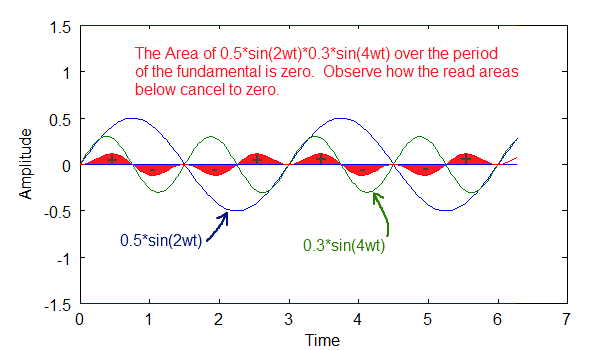Extracting The Coefficients of the Sinusoids
|
To extract the coefficients of the sinusoids a trigonometric identity is required, the orthogonality principle.
The Orthogonality Principle
Here again is the general form of the Fourier Series:
Equation 1
Here we want to extract the sine wave and cosine wave components of a complex, periodic wave. In the equation above that means coefficients a1, a2, a3, ... and b1, b2, b3, ....
The orthogonality principle only holds when sine waves are integer multiples of each other, such as is the case for periodic waves! So, this principle beautifully works for a Fourier series. The principle applies to both sine waves and cosine waves.

Equation 2

Equation 3
Equations 2 is the orthogonality principle for sine waves and equation 3 is the orthogonality principle for cosine waves. If the integers m and n are not equal, this means that the total area will be zero. However, if m and n are equal, the total area will be some non-zero number.
This principle, or method, allows you to take a complex wave function, f(t), and extract the coefficients for the sine and cosine waves for the Fourier series that describes that function. Below are the two key equations, 4 and 5, for Fourier Series coefficient extraction.

Equation 4

Equation 5
So, if you are given a complex wave form, f(t),with a fundamental period, T, then you can extract the coefficient values for the Fourier Series, equation 1, to describe that complex wave using equations 4 and 5 above. This often takes a great deal of meticulous work, because each coefficient for each integer multiple of frequencies of the sine and cosine components has to be extracted one at a time. Today we rely on high speed computers to speed this process up by several orders of magnitude.
How The Orthogonality Principle Works
Now that we have the equations and an understanding of how to pull out the coefficients, next we will look under the hood to see how orthogonality works.
The graph below shows how the total area is positive when two sine waves (or cosine waves) have the same frequency:

Above diagram shows how two waves of the same frequency result in a net positive area.
The graph below shows how the total area is zero when two sine waves have different m's and n's. In this case m=2 and n=3.

Above diagram shows how the total area is zero when the sine waves have different frequencies.
The graph below is another example of how the total area is zero when m and n are not equal. In this case m+2 and n = 4.

Above diagram shows an example of how the total area is zero when the sine waves have different frequencies.
So, imagine a complex, periodic sinusoidal wave, f(t). It is composed of several sinusoidal components, but we don't know what they are yet. Using the orthogonality principle thus:
[equation to extract coefficient at a frequency using orthogonality with f(t)]
We can check to see if a frequency exists or not. If the frequency does not exist, then the area of a sinusoid will be zero. If the frequency exists, we will get a non-zero value, which will be that coefficients value. We need to check each frequency in turn to see if it exists or not, which, admittedly, is a lot of work (digital methods, DFT and FFT speed this up tremendously). We do this for both the sine part and the cosine part. The sine and cosine of a particular frequency are what determine the phase of the sinusoid. We discussed that when we looked at the general equation of the Fourier Series.
Orthogonality for sin(mwt)*cos(nwt)
There is one more identity required to tighten this up. Orthogonality for sine and cosine is always zero.

Equation 6
So, this means that the sine and cosine elements will not interfere with each other when extracting one or the other. Below is a graph showing how the total area is zero for a cos(mwt)*sin(nwt). In this case, it is always zero for all integer multiples, m and n.

Above diagram shows how the area is zero when a sine wave and cosine wave are multiplied and integrated over the fundamental period.
|

